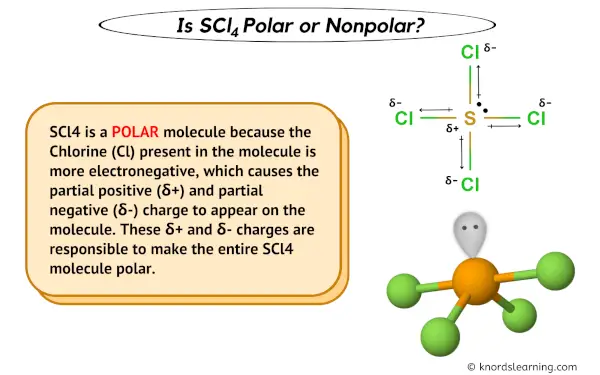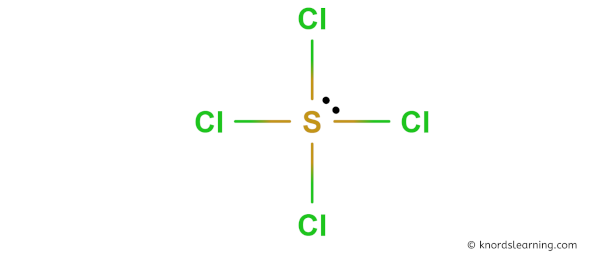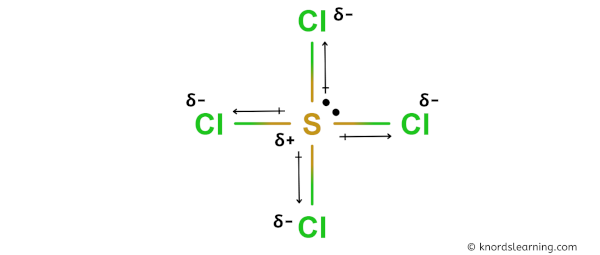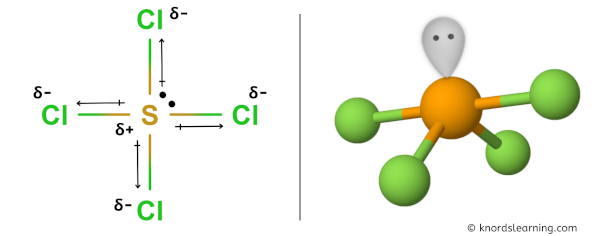
SCl4 is a POLAR molecule.
But why?
And how can you say that SCl4 is a polar molecule?
Want to know the reason?
Let’s dive into it!
SCl4 is a POLAR molecule because the Chlorine (Cl) present in the molecule is more electronegative, which causes the partial positive (ẟ+) and partial negative (ẟ-) charge to appear on the molecule. These ẟ+ and ẟ- charges are responsible to make the entire SCl4 molecule polar.
Let me explain this in detail with the help of SCl4 lewis structure and its 3D geometry.
Why is SCl4 a Polar molecule? (Explained in 3 Steps)
SCl4 is a polar molecule because it has poles of partial positive charge (ẟ+) and partial negative charge (ẟ-) on it.
Let me explain this to you in 3 steps!
Step #1: Draw the lewis structure
Here is a skeleton of SCl4 lewis structure and it contains four S-Cl bonds.

(Note: If you want to know the steps of drawing the SCl4 lewis dot structure, then visit this article: SCl4 lewis structure, Or you can also watch this short 2 minute video).
So from the above diagram we have come to know that the SCl4 molecule has four S-Cl bonds.
Now in the next step we have to check whether these S-Cl bonds are polar or nonpolar.
And we also have to check the molecular geometry of SCl4.
Step #2: Check whether individual bonds are polar or nonpolar
The chemical bonds can be either nonpolar, polar or ionic depending on the difference of the electronegativity values (ΔEN) between the two atoms.

Have a look at the above image.
- If the electronegativity difference (ΔEN) is less than 0.4, then the bond is nonpolar covalent bond.
- If the electronegativity difference (ΔEN) is between 0.4 to 1.7, then the bond is polar covalent bond.
- If the electronegativity difference (ΔEN) is greater than 1.7, then the bond is an ionic bond. [1] [2] [3] [4] [5]
Now let’s come to the example of SCl4 molecule. It has four S-Cl bonds.
You can see the electronegativity values of Sulfur (S) and Chlorine (Cl) atoms from the periodic table given below.

From the above image;
Now let’s see the polarity of each bond.
For S-Cl bond;
The electronegativity difference (ΔEN) = 3.16 – 2.58 = 0.58
This value lies between 0.4 to 1.7, which indicates that the bond between Sulfur (S) and Chlorine (Cl) is polar.
Hence, the S-Cl bond is a polar covalent bond.

You can see in the above image that because of higher electronegativity of Chlorine atom, the partial positive charge (ẟ+) appears on the Sulfur atoms (S) and partial negative charge (ẟ-) appears on the Chlorine atom (Cl).
But wait, we also have to look at the molecular geometry of SCl4 to know whether it has a symmetric shape or not.
Step #3: Check whether the molecule is symmetric or not
Have a look at this 3D structure of SCl4. The Sulfur atom (S) is at the center and it is surrounded by 4 Chlorine atoms (Cl).
It also has one lone pair on the Sulfur atom (S).

Due to the lone pair on the sulfur atom (S), its molecular geometry becomes asymmetric.
Because of this, there are positive and negative poles of charges on the overall molecule of SCl4.
Hence, the SCl4 molecule is a polar molecule.
I hope you have understood the reason behind the polar nature of SCl4 molecule.
See the polarity of other molecules to make your concepts clear:
Is NI3 Polar or Nonpolar?
Is IF3 Polar or Nonpolar?
Is ClF5 Polar or Nonpolar?
Is SCN- Polar or Nonpolar?
Is ICl5 Polar or Nonpolar?
Jay is an educator and has helped more than 100,000 students in their studies by providing simple and easy explanations on different science-related topics. With a desire to make learning accessible for everyone, he founded Knords Learning, an online learning platform that provides students with easily understandable explanations.
Read more about our Editorial process.
